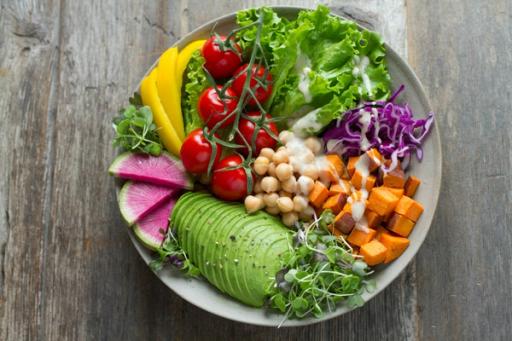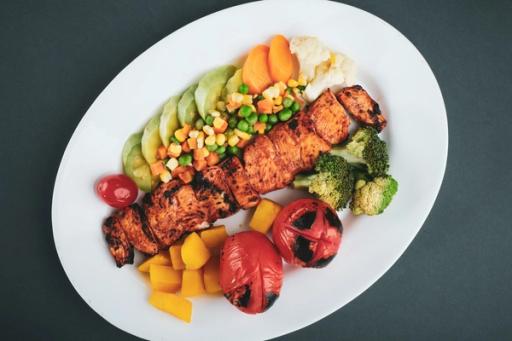
Macros can feel like a puzzle sometimes, especially if you're trying to lose weight or improve body composition. One day, you might hit your targets perfectly. The next day, you might be way off. The more you track macros, the easier it gets to create balanced meals that help you hit your targets. But what happens when you want to hit your macros every day?
What if you want to reach that goal to create a perfectly balanced diet that fuels your body, supports your goals, and fits seamlessly into your lifestyle without stress or restriction? Learning how to hit your macros can help you achieve all these objectives. This article will teach you exactly how to hit your macros so you can better your health without sacrificing your happiness. Cal AI's calorie tracker can make hitting your macros daily a breeze. This easy-to-use tool will help you effortlessly create a balanced diet that supports your goals, whether for muscle gain, fat loss, or maintenance.

If you’re under the impression that math has no place in the kitchen, it’s time you got to grips with a macro calculator. Whether you’re looking to bulk up or lean down (or both simultaneously), calculating macros can help you progress at a rate you’ve never seen, even if you’re already tracking calories. And we’ll tell you why.
Tracking macros provides information about the relative and absolute amount of:
According to Dr. Tom Little, a performance and nutrition specialist for HeroPro Sport, an individual can track total calorie intake.
“It also affects our nutrition behaviours, as we are more likely to plan our diet and be conscious of the quality of our nutrition.”
As anyone who’s tried to build muscle or lose belly fat will attest, there’s far more to creating your ideal body shape than nailing workouts 24/7. By learning how to calculate macros, you’ll:
That’s why a macro calculator is one of the most effective tools for:
Macronutrients are the bulk of the matter that makes up the energy content of every piece of food you’ve ever eaten. Protein, carbohydrates, and fat are the three 'macros' in your food, and they all contribute to your overall calorie intake in different ways.
Each macronutrient is measured in grams and calories, which will contribute to your daily goal. By tweaking each quantity with a macro calculator, you can fuel your body for any training, whether prepping for a photoshoot or an endurance race.
Learning how to count your macros means paying close attention to the make-up of your food. This helps you understand why you might not lose as much fat or muscle as you’d like. Then, using our macro calculator below, you can tailor your diet to get granular on your gains.
Protein is made up of long chains of amino acids. Around 20 different amino acids are commonly found in plant and animal proteins. Nine are 'essential,' meaning the body can't make them, and you must obtain them through your diet.
Protein and numerous metabolic functions are crucial for muscle growth and repair. Examples of high-protein foods include:
Carbohydrates often get a bad rap, but they’re vital to your health. They’re the most important energy source for your body, which converts carbs into glucose to fuel your:
This is why endurance athletes and highly active individuals follow a high-carbohydrate diet. While both ‘simple’ and ‘complex’ carbohydrates are sugars, they differ.
Simple carbohydrates are fast-digesting sugars found naturally in certain foods like:
These foods are also added to:
Complex carbohydrates, also called starches, contain longer chains of sugar molecules, which take longer to:
They’re found in:
Fat gets a bad rap, but in truth, fatty acids, the building blocks of fat, such as omega-3, are essential to your health. They play several crucial roles, from protecting your organs to acting as chemical messengers for proteins.
Fat also helps your body absorb vitamins A, D, and E. Unsaturated fats help protect your heart by regulating cholesterol. These include:
You’ll find healthy fats in:
A macro calculator is used to identify the proportion of proteins, carbs, and fats you should be eating as part of your daily calorie intake to support your specific goals. Whether that’s fat loss, muscle gain, or purely weight maintenance, you input your individual and unique metrics to unearth ratios that are optimum for you.
“Macros have differing effects on our bio-physiology, making them suited towards differing goals,” says Dr. Little. Take weight loss, which requires you to eat fewer calories than you burn. Your protein intake would increase, “as it has the lowest net calories, helps us feel full, minimises muscle loss, elevates our metabolism, and provides important nutrients,' he says.
Fat would take a backseat, “as it contains more than double the calories of carbs and protein – unless following a keto diet where fat is elevated and carbs are minimised,” Dr. Little continues. Carbs would vary depending on your activity levels, “but the general advice would be to moderate carbs.”
To gain muscle, you need to eat more calories than you expend. “A greater proportion of fat is allowed in the diet,' says Dr. Little. You’ll also eat more carbs, which will help you hit your calorie target, as well as 'fuel strength training, which helps promote muscle gains,” he says. 'Protein remains important, as it’s the building block for the new muscle tissue.'

Grab a pen and follow our macro calculator below to determine your needs. Once you know how to calculate your macros, you’ll never look back:
First, you'll need to work out your BMR. Your basal metabolic rate is the number of calories you take and burn each day at rest. Your BMR factors in your weight, activity level, and gender to give a final figure.
The most popular way to estimate BMR is through the Harris-Benedict formula, which uses weight, height, age, and gender to identify BMR. Identifying this figure can help one gain, lose, or maintain weight. Here’s how to find your BMR:66 + (6.23 × weight in pounds) + (12.7 × height in inches) − (6.8 × age in years) = BMRYou can calculate your BMR using this formula. It’s the bare minimum your body needs to function day to day, and deviating below this level can affect your health and energy levels.
This step involves factoring in my current activity level. I can identify mine by multiplying the total calorie count (above) by the following method:Little or no exercise: 1.2Light exercise a few times a week: exercise a few times a week: 1.375Moderate exercise 3-5 times a week: 1.55Heavy exercise 6-7 times per week: 1.725We’ll say an example male exercises three times a week, which places him in the ‘moderate exercise’ category. Multiplying the BMR by the activity level will give a total calorie count called my TDEE, or total daily energy expenditure (1,665 x 1.55 = 2,580.75).This means you’ll need to eat 2,580 calories daily to maintain your weight. To lose weight, you’ll cut this count by no more than 15 percent for manageable weight loss. To gain, you’ll crank it up by the same amount.
The next step of the macro calculator is to figure out how to split those calories to meet your goal. A popular splitting method involves dicing this number by a 40/40/20 percent rule in protein, carbs, and fat. It’s important to acknowledge that no single ratio works for everyone. Experts agree that protein should take priority.
Some people do well on lower-carb plans, while others do well on lower-fat plans. It all depends on the individual, says Brad Schoenfeld, PhD, director of the Human Performance Lab at CUNY Lehman College. The scientific literature clearly shows that getting the proper amounts of protein is the most important thing to:
Using the 40/20/20 ratio, the diet for the example man will look like this:2580 x 0.40 (protein) = 1,032 calories2580 x 0.40 (carbohydrates) = 1,032 calories2580 x 0.20 (fat) = 516 caloriesTotal: 2,580 calories
To identify specific macro amounts, divide each according to the calories per gram. As a reminder, that’s 4 for protein, 4 for carbs, and 9 for fat:(2580 x 0.40 (protein) = 1,032 calories) ÷ 4 = 258g(2580 x 0.40 (carbohydrates) = 1,032 calories) ÷ 4 = 258g(2580 x 0.20 (fat) = 516 calories) ÷ 9 = 57g
Now that you’ve used the macro calculator, you have all the information you need to tune your nutrition to suit your training schedule. To make sure you’re adhering to your chosen macronutrient split, download a food diary app, input your metrics, and it’ll calculate your totals and let you know how much of each macro is left.
Utilized effectively, a macro calculator can teach you to eat in a way that fulfills your goals without leaving your stomach growling, and the knowledge you amass from learning how to calculate macros lasts long after you ditch the tracking app. Mapping out your meals can help, but you don’t have to be too regimented or meticulous in your approach.
There’s a reason macro-counting is often called flexible dieting. You can make space for an extra scoop of PB in your protein shake (or a packet of crisps at lunch) without being thrown off track. That said, totally winging it day by day means you’re more likely to miss the mark repeatedly.

Don’t wait until the end of the day to figure out what macros you’re missing. Spend a few minutes in the morning (or the night before) to plan a successful day. When you have a full day of macros to work with, you can make room for foods you enjoy and experiment with variety. Pro tip: You don’t have to have everything cooked and portioned out to put it in your food tracker ahead of time. Keep tabs on what is in your refrigerator, know what you want to cook, and then plan portion sizes accordingly based on your daily macro needs.
Enter the most important pieces of your day first, based on your preferences and priorities. Maybe it is your post-workout meal, the easy grab-and-go breakfast you rely on, the lunch you already have prepped, or the dinner you’re looking forward to. Starting with staples gives you a solid idea of the leftover macros you must play with. Pro tip: Make sure your staples include:
These are the toughest things to get enough of when you aren’t intentional about it.
Consider your favorite foods (this can include a treat!). A nutrition plan that doesn’t bend will break; at WAG, we don’t believe in “good” or “bad” foods. Leaving room for your favorites (looking at you, Cadbury Chocolate Eggs, or a glass of wine with friends on a Saturday night!) is essential to long-term diet success and sustainability. Pro tip: Treats are generally higher in carbs and fats, so you may not be able to enjoy all of your favorites on the same day. Remind yourself that your numbers reset in the morning and that you can always enjoy a different favorite tomorrow!
After adding your staples and favorites:
Pro tip: Don’t just look at how many macros you’ve used! Utilize your tracker’s charts and graphs to monitor how many macros you have left as you add foods.
Did you go over your macros? Planning is so helpful. It allows you to adjust before you eat something and feel stuck. Cut back on a few portion sizes (you probably won’t have to delete anything entirely). A few minor tweaks across your entire day should bring you back within your ranges without significantly impacting your meal size or food choices. Check, tweak, and repeat until you find the right combination of foods to achieve your macro goals. Pro Tip: Nothing is set in stone until you’ve eaten it, so don’t stress if you have to go back and adjust. This holds if something throws off your day. You can adapt macros as you eat if necessary, but planning as much ahead of time is still ideal and helps limit frustration and not-so-great choices in moments of stress or hunger.
Even if you’ve gone over on one or more macros, do your best to hit your remaining targets. We’d rather you go a little over on one macro than not hit another. If you are already 4 grams over on fat but still need 30 grams of protein, drink that protein shake or eat that chicken breast, even if it has 1-2 grams of fat! You can still get those green thumbs at the end of the day if you get within 5 grams of protein, 5 grams of carbs, and 2 grams of fat of your daily targets.
Cal AI transforms calorie tracking with cutting-edge AI technology. Just snap a photo of your meal, and we'll do the rest. Our app combines your phone's depth sensor with advanced AI models to:
With 90 percent accuracy on visible foods and multiple tracking options like barcode scanning, food label recognition, and manual description for complex items like smoothies, we've made nutrition tracking effortless. Gone are the days of tedious manual logging calorie tracking apps.
Whether scanning a full meal or a quick snack, Cal AI gives you accurate nutritional information in under 15 seconds. Plus, our AI learns from your feedback, continuously improving its accuracy. Stay on track with personalized insights and smart reminders.
Cal AI makes achieving your fitness goals simpler than ever. Track your calories with your camera with Cal AI's AI calorie tracker today.